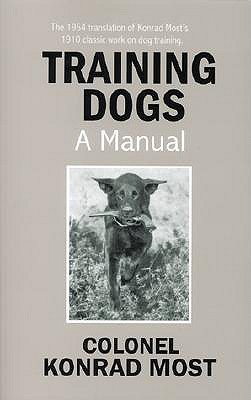Training Dogs: A Manual

Training Dogs: A Manual
**Please note that Dogwise does not endorse all of the training methods used in this book; it is a historical document and an early example of modern dog training. Today's dog trainer can trace the roots of modern training to Training Dogs by Colonel Konrad Most. Written in Germany in 1910, Training Dogs influenced how both dogs and trainers were taught in Europe and the United States for the next 50 years! It contains valuable and historically significant information, a true classic. 21st century trainers and behaviorists will find it amazing to realize that early in the 20th century Konrad Most was using and applying behavioral training principles with dogs long before B.F. Skinner! Most also created systematic and scientific methods to teach trainers how to train dogs with his " Theory of Training." While Most's methods may be viewed as harsh by modern dog trainers, the theory behind it was revolutionary for it's time and it is still applied today. Discover the roots of behavioral trainingSeeing the world from a dog's point of view.Utilizing instinctual behavior in training such as the prey drive.Use of compulsion and inducements. Use of primary and secondary reinforcers. Learn how Most TaughtObedience exercises including the recall, jumping and retrieving.Guard and schutzhund training.Reconnaissance and tracking; scent theory.Water work for hunting dogs. Dogs for the blind.Here is what today's dog trainers say about Training DogsMost demonstrated an understanding of operant conditioning concepts such as primary and secondary reinforcement, shaping, fading and chaining 28 years before the publication of B.F. Skinner's The Behavior of Organisms. He differentiated between primary and secondary reinforcers. He used his voice and soft tones as secondary inducements, much the way some trainers use clicks today.Mary Burch & Jon S. Bailey authors of How Dogs LearnAlthough some of Most's methods seem archaic and harsh in this enlightened age of positive training, some of the theory he set forth was years ahead of its time. Knowing where training came from helps us appreciate where we are today. Sheila Booth author of Purely Positive Training and co-author of Schutzhund Obedience Training in DriveKonrad Most was a police dog, war dog and seeing-eye dog trainer in Germany for the first half of the 20th Century. He trained dogs in World Wars I AND II and created curricula for trainers. He was a researcher in the field of canine psychology and trained dogs for
PRP: 139.11 Lei
Acesta este Prețul Recomandat de Producător. Prețul de vânzare al produsului este afișat mai jos.
125.20Lei
125.20Lei
139.11 LeiLivrare in 2-4 saptamani
Descrierea produsului
**Please note that Dogwise does not endorse all of the training methods used in this book; it is a historical document and an early example of modern dog training. Today's dog trainer can trace the roots of modern training to Training Dogs by Colonel Konrad Most. Written in Germany in 1910, Training Dogs influenced how both dogs and trainers were taught in Europe and the United States for the next 50 years! It contains valuable and historically significant information, a true classic. 21st century trainers and behaviorists will find it amazing to realize that early in the 20th century Konrad Most was using and applying behavioral training principles with dogs long before B.F. Skinner! Most also created systematic and scientific methods to teach trainers how to train dogs with his " Theory of Training." While Most's methods may be viewed as harsh by modern dog trainers, the theory behind it was revolutionary for it's time and it is still applied today. Discover the roots of behavioral trainingSeeing the world from a dog's point of view.Utilizing instinctual behavior in training such as the prey drive.Use of compulsion and inducements. Use of primary and secondary reinforcers. Learn how Most TaughtObedience exercises including the recall, jumping and retrieving.Guard and schutzhund training.Reconnaissance and tracking; scent theory.Water work for hunting dogs. Dogs for the blind.Here is what today's dog trainers say about Training DogsMost demonstrated an understanding of operant conditioning concepts such as primary and secondary reinforcement, shaping, fading and chaining 28 years before the publication of B.F. Skinner's The Behavior of Organisms. He differentiated between primary and secondary reinforcers. He used his voice and soft tones as secondary inducements, much the way some trainers use clicks today.Mary Burch & Jon S. Bailey authors of How Dogs LearnAlthough some of Most's methods seem archaic and harsh in this enlightened age of positive training, some of the theory he set forth was years ahead of its time. Knowing where training came from helps us appreciate where we are today. Sheila Booth author of Purely Positive Training and co-author of Schutzhund Obedience Training in DriveKonrad Most was a police dog, war dog and seeing-eye dog trainer in Germany for the first half of the 20th Century. He trained dogs in World Wars I AND II and created curricula for trainers. He was a researcher in the field of canine psychology and trained dogs for
Detaliile produsului










